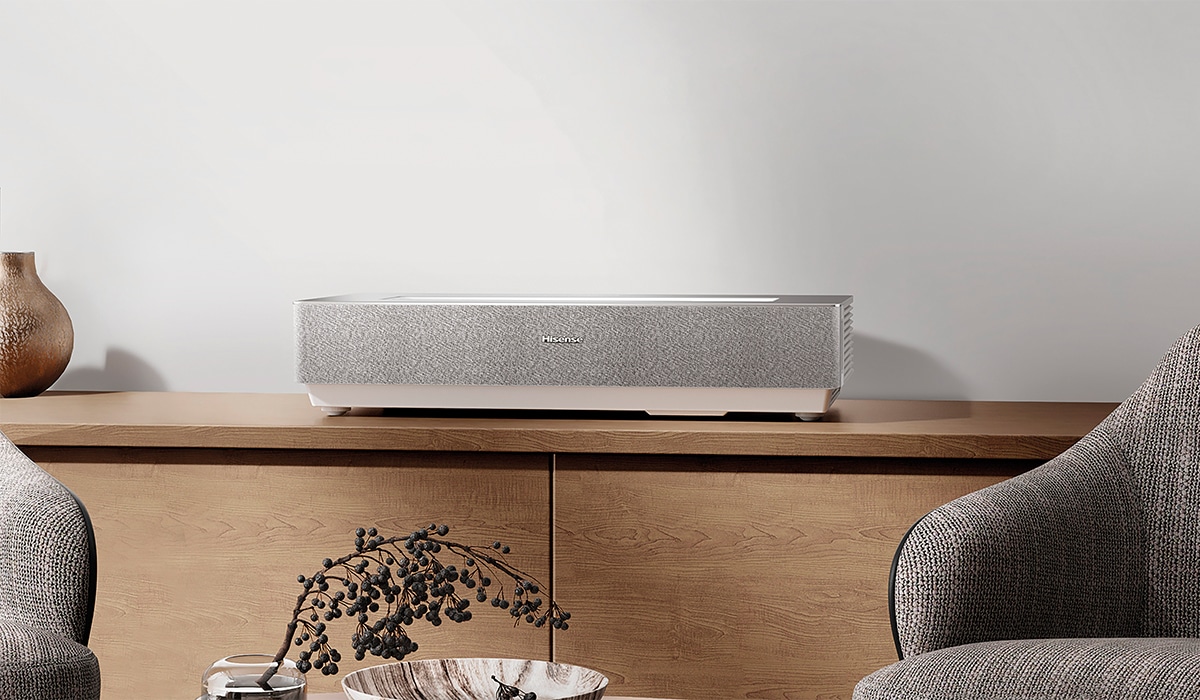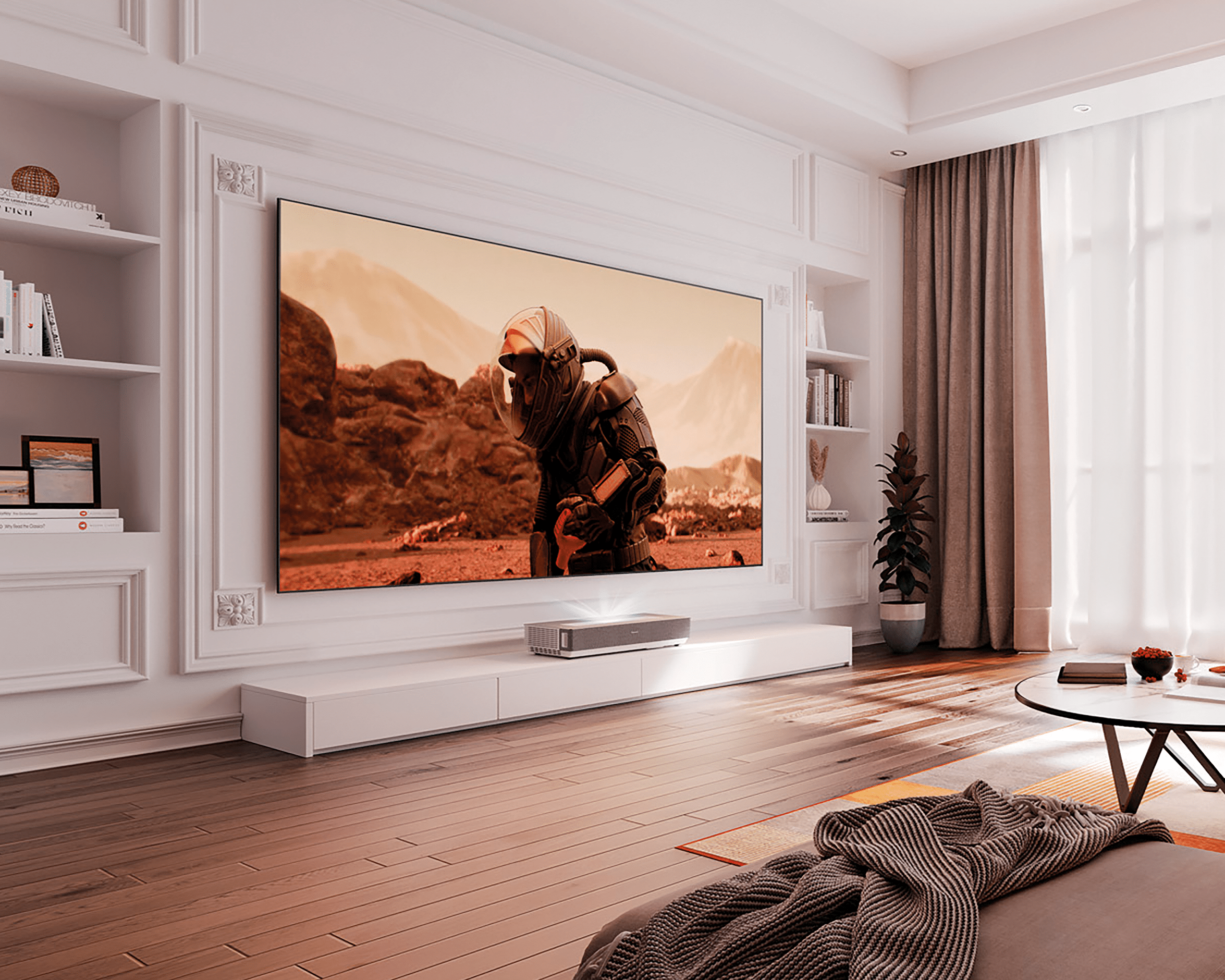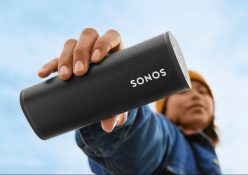If you’re looking for a home-cinema option, Hisense’s 100-inch laser TV is worth your consideration.
Hisense 100L5H 100” 4K Laser TV
The term “laser TV’ is a bit of a misdirection as they are not TVs, they are ultra-short throw projectors with a TV tuner installed. The advantage of this over normal projectors is that you can place the unit right in front of the screen, instead of mounted up on a wall on the other side of the room, which often also comes with complications of having to run cables around.
I have been told that when you buy the Hisense 100L5H 100′ 4K Laser TV it’s delivered by people who know how to install it, although I would advise checking that if you do purchase one. Installation takes a couple of hours, mainly to build the screen as a frame is clipped together out of a box full of components before the screen is rolled on to this and clipped into place, and it requires two people to build and mount. The screen, which is 2.5 metres (diagonal), isn’t mounted on your wall directly. Instead two mounting brackets are installed on the wall and a top rail at the back of the screen rests on top of two pins secured by the mounting brackets. It is designed like this so that you can adjust the mount/screen position (the pins are screws that can be moved up and down by a few centimetres) but it means that the screen is always hanging a little precariously by just two points and if you have boisterous kids or animals, or just one of those Cape Town days when the wind suddenly gusts at high speed, the screen might go flying. I don’t like the system at all and would rather just have a screen that is bolted into the wall since you are making holes anyway for the mounts.
After that you place the console at least 30 cm in front of the screen on a furniture surface, bearing in mind that once you set it up you shouldn’t be moving it – there are even sticky foot mounts in the box that you can use to secure it firmly to the surface if you want to. Finally, you switch it on and run through the screen-alignment process (keystone correction), using the remote to fine tune the projection.
On-Screen Setup
Once you’re in it’s smart TV land so there are numerous terms and conditions you’ll have to agree to before you can access certain services or use certain features.
The remote has buttons for all the common services – Netflix, Amazon Prime Video, Plex, DSTV, Showmax, VIDAA, and the YouTube app, for example – or you can access any devices you’ve plugged into the console via a file explorer. There are extensive settings in the menus for setting up visual options, including colour temperature, gamma, and motion smoothing. Motion smoothing was a particular irritation as it seemed to switch on every time I flipped to a different service and I was forever having to switch it off again.
The YouTube app was another irritation as, although the console supports 4K, the app was downsampling all the video, even though I had the YouTube settings at the highest resolution and the testing Internet connection was fast enough.

Sound And Vision
For actual high-resolution video, the console supports both HDR10 and Dolby Vision, and this is where the picture quality really stands out. I tested using Dolby Vision sample fi les that came directly from Dolby (and on a hard drive, not streamed) and the quality was impressive. The colours are bright, rich, and crisp – in fact, this is true even with lower-resolution video – and the video quality is exceptional. However, being a projector, the one area in which you lose quality is rich, deep blacks. The console just isn’t capable of it, although you won’t notice if you’re watching something with vivid colour. You do begin to notice, however, in a room that’s got a lot of ambient light and, with the current trend of Hollywood movies and TV being dark and badly colour graded, you will also notice it while watching modern cinema.
Unlike many projectors this one is designed to work in ambient light – and it does – but there’s still a very noticeable difference in the quality between that and watching in a dark room. The viewing angle is also strange and not impressive. If you’re a couple of metres away and drift just slightly off the centre line the sides of the screen become noticeably darker but if you’re far away (in other words, in a very big room) then you have much more room to be off the centre line while still seeing a full good picture.
On the sound side the console supports Dolby Atmos but I did not have a sound system connected to the console and only used the device’s internal stereo speakers. In general the sound is very good (and capable of being cranked up very loud) – but only up to a point. High and mid-range notes are very crisp and clear and percussion instruments sound particularly impressive but there’s no subwoofer and so there’s absolutely no bass at all. You don’t even hear a hint of it. Every note below a certain range is just gone. Therefore I would recommend getting a sound system to go with the projector, which most people presumably would.
Along with the screen and console you get the remote, two AA batteries, a USB extender cable to make it easier to plug in a USB drive (note: no HDMI cables), and two sets of gloves and a reflector cleaning kit for keeping the screen and console dust free.
In terms of picture quality, this projector really is at its best when it’s projecting Dolby Vision video and, as far as I know, the only streaming service that supports it locally is Netflix. It’s not the projector’s fault but it is a lot to pay if your primary intention is not specifically to watch TV in Dolby Vision.
This device isn’t for everyone. There’s only a particular group of consumers who are going to want an ultra-short-throw projector over a normal projector or an OLED or microLED TV but, for them, this is a great option, especially at a sub-R50 000 price. I went in feeling sceptical and came out won over (except for the awful screen-hanging system).
R34 999 (HiFiCorp)
hisense.co.za/products/hisense-100-4k-laser-tv-100l5h/
Specifications
Console dimensions: 6.6×12.1×32 cm
Max resolution: 3840×2160
Screen size: 100 inches (2.5 metres)
Ports: Digital audio out, Ethernet, USB X2, headphone, antenna (satellite), antenna (VHF/UHF), CI+ CAM, HDMI X3
Connectivity: Wi-Fi, Ethernet
By: Mandy J Watson
Imagery: Supplied







